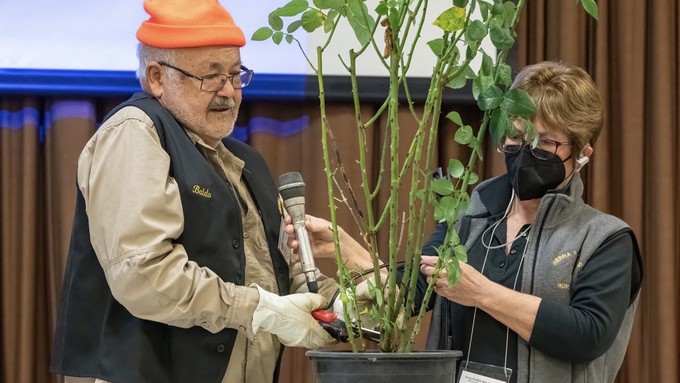
Warmer weather brings out rapid rose growth

Baldo Villegas demonstrates his 3-minute rose-pruning method at a 2022 workshop. At right is fellow rosarian Charlotte Owendyk. Photo courtesy Sierra Foothills Rose Society
It’s almost the end of January and I’m facing another deadline – completion of my annual rose pruning. And this time, Mother Nature is putting on the pressure.
Our winter deluge – nearly three consecutive weeks of rain – put me way behind in this yearly chore. Before Christmas, it was so warm and dry, my roses kept blooming – so I kept procrastinating. (It was the holidays; I had things to do I liked more than tangling with prickly bushes.) After Christmas, it did nothing but rain.
I’m not alone in this predicament; many gardeners are trying to beat the calendar – or growth hormones.
Sacramento rose lovers try to get our bushes pruned before Valentine’s Day. It’s a semi-arbitrary deadline; roses are dormant during the chilly winter months and a lot easier to prune. Roses start growing again as soon as the weather warms, usually after a round of deep-soaking rain. That combination usually hits sometime in late February or early March.
Our January storms were not only wet (and deep soaking), but warm. Afternoon temperatures have been edging close to 70 degrees. And that prematurely woke up my roses. Suddenly, I had bud breaks and new growth everywhere – and a real mess.
I squeezed a little pruning in between storms, but it was mostly to bushes adjacent to firm footing on the patio or driveway. Finally, the ground in my garden was dry enough this week for me to plunge into serious pruning; 120 bushes done and 20 to go.
How did I get through so many roses so quickly? I kept remembering Baldo’s three-minute method.
Baldo Villegas, best known as Sacramento’s Bug Man, is a retired state entomologist and master rosarian. He also grows a tremendous number of roses – about 3,000 bushes. To tackle that many plants, Baldo came up with a strategy: Start from the bottom. Look at the base of the plant, determine what canes to keep and what to cut. Then, go for it.
Often, you’ll need to start at the top, too, especially if it’s a very large bush. Cut the rose down nearly to the height it should be when blooming (usually 4 feet tall for hybrid teas). Then, sort out the canes.
Baldo’s method simplifies the process of rejuvenating the plant. Pruning back to the same points year after year does not make good roses; it shortens the life of the plant and limits its growth. By focusing on strong, healthy, younger canes, pruning allows those “keeper” canes to flourish – and flower more.
Baldo recently explained his method during the Sierra Foothills Rose Society’s annual winter rose care workshop. The podcast team from Green Acres Nursery & Supply was on hand to record Baldo in action and get his tips.
“These rose pros share their best methods for pruning, and a few safety tips while working with these prickly plants,” says Green Acres. “With some goatskin gloves, and Baldo’s bottom-to-top technique, you’ll be pruning like a master rosarian in no time.”
Listen to the podcast here: https://www.buzzsprout.com/1610311/12058108-winter-care-for-roses.
Comments
0 comments have been posted.Sacramento Digs Gardening to your inbox.
Food in My Back Yard Series
May 6: Maintain soil moisture with mulch for garden success
April 29: What's (already) wrong with my tomato plants?
April 22: Should you stock up on fertilizer? (Yes!)
April 15: Grow culinary herbs in containers
April 8: When to plant summer vegetables
April 1: Don't be fooled by these garden myths
March 25: Fertilizer tips: How to 'feed' your vegetables for healthy growth
March 18: Time to give vegetable seedlings some more space
March 11: Ways to win the fight against weeds
March 4: Potatoes from the garden
Feb. 25: Plant a fruit tree now -- for later
Feb. 18: How to squeeze more food into less space
Feb. 11: When to plant? Consider staggering your transplants
Feb. 4: Starting in seed starting
Sites We Like
Garden Checklist for week of May 11
Make the most of the lower temperatures early in the week. We’ll be back in the 80s by Thursday.
* Plant, plant, plant! It’s prime planting season in the Sacramento area. Time to set out those tomato transplants along with peppers and eggplants. Pinch off any flowers on new transplants to make them concentrate on establishing roots instead of setting premature fruit.
* Direct-seed melons, cucumbers, summer squash, corn, radishes, pumpkins and annual herbs such as basil.
* Harvest cabbage, lettuce, peas and green onions.
* In the flower garden, direct-seed sunflowers, cosmos, salvia, zinnias, marigolds, celosia and asters. (You also can transplant seedlings for many of the same flowers.)
* Plant dahlia tubers.
* Transplant petunias, marigolds and perennial flowers such as astilbe, columbine, coneflowers, coreopsis, dahlias, rudbeckia and verbena.
* Keep an eye out for slugs, snails, earwigs and aphids that want to dine on tender new growth.
* Feed summer bloomers with a balanced fertilizer.
* For continued bloom, cut off spent flowers on roses as well as other flowering plants.
* Add mulch to the garden to maintain moisture. Mulch also cuts down on weeds. But don’t let it mound around the stems or trunks of trees or shrubs. Leave about a 6-inch-to-1-foot circle to avoid crown rot or other problems.
* Remember to weed! Pull those nasties before they set seed.
* Water early in the day and keep seedlings evenly moist.